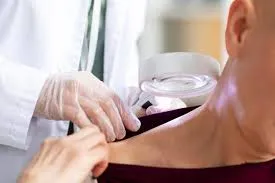
Skin changes can be challenging to interpret without proper information and knowing what to look for. While some variations are harmless, others may suggest underlying concerns that require professional evaluation. Understanding when to consult a dermatologist assures you are proactively monitoring your skin’s health. Here is more information on key indicators to watch for and information to help you identify when a dermatologist might be necessary:
Suspicious Moles or Freckles
Moles and freckles are common, but changes in their appearance can sometimes signal the need for closer attention. A dermatologist often discusses the “ABCDEs” of mole evaluation. This can help individuals recognize concerning features or changes in their skin:
- A – Asymmetry: When one half of a mole does not match the other in shape or size, it may warrant further assessment.
- B – Border: Irregular, blurred, or poorly defined edges can indicate potential concerns.
- C – Color: Moles with multiple colors (such as brown, black, red, or white) or noticeable changes in color should be monitored closely.
- D – Diameter: Growth larger than 6mm (roughly the size of a pencil eraser) can indicate the need for investigation.
- E – Evolving: Any mole that changes in size, shape, color, or texture over any period of time should be assessed.
It is key to be on the lookout for these signs during regular self-checks of the skin and to seek professional advice for any abnormalities you detect.
Abnormal Skin Changes
Suspicious skin changes can go beyond moles or freckles. There are a variety of skin irregularities that individuals should monitor:
- Non-Healing Lesions: Wounds or scabs that do not heal within several weeks may indicate an underlying issue and require evaluation.
- Sudden Texture Changes: Skin that becomes rough, scaly, or develops other unusual textures without explanation may need examination.
- New Growths: The sudden appearance of lumps, bumps, or lesions that grow or change rapidly may require dermatologist attention.
- Itching or Pain: Skin changes accompanied by persistent itching or unexplained pain can signal the need for further investigation.
Being proactive about these skin changes allows for timely evaluations, further reducing risks associated with delayed action or lack of knowledge.
Other Risk Factors
Certain scenarios make it especially necessary to consult a dermatology professional. Those with a personal or family history of skin cancer or higher exposure to ultraviolet (UV) rays should have routine skin check-ups. Chronic skin conditions like persistent rashes, discoloration, or other issues that do not improve with over-the-counter treatments may indicate underlying problems requiring medical attention. Sudden or unusual symptoms, such as excessive bleeding, ulceration, or signs of infection, also warrant evaluation by a trained dermatologist.
Find a Dermatologist
Monitoring your skin for changes and recognizing abnormalities is a key aspect of maintaining overall health. Suspicious moles, freckles, or other unexplained skin irregularities deserve the attention of a qualified dermatologist. Understanding what to observe and when to consult a professional helps safeguard against potential risks to your skin’s well-being. Regular self-checks and prompt evaluation can provide peace of mind while facilitating early intervention when required.
